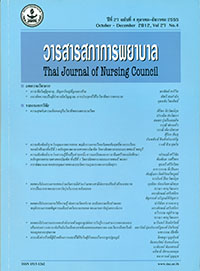ความสัมพันธ์ระหว่างความรู้สึกเป็นส่วนหนึ่ง ความเครียด และภาวะซึมเศร้าของนักศึกษาหลักสูตรพยาบาลศาสตรบัณฑิต ชั้นปีที่ 1 วิทยาลัยพยาบาลบรมราชชนนี พะเยา
Keywords:
ความรู้สึกเป็นส่วนหนึ่ง, ความเครียด, ภาวะซึมเศร้า, นักศึกษาพยาบาลศาสตรบัณฑิตวิทยาลัยพยาบาล, sense of belonging, stress, depression, nursing majorsAbstract
บทคัดย่อ
การวิจัยเชิงพรรณนา (descriptive study) มีวัตถุประสงค์เพื่อ (1) ศึกษาระดับความรู้สึกเป็น ส่วนหนึ่ง ความเครียด และภาวะซึมเศร้า (2) เปรียบเทียบค่าเฉลี่ยของคะแนนความรู้สึกเป็นส่วนหนึ่ง ความเครียด และภาวะซึมเศร้า และ (3) ศึกษาความสัมพันธ์ระหว่างความรู้สึก เป็นส่วนหนึ่ง ความเครียด และภาวะซึมเศร้า ของนักศึกษาพยาบาลชั้นปีที่ 1 ในเดือนแรก เดือนที่ 4 และเดือนที่ 7 ของการเข้าศึกษา วิทยาลัยพยาบาลบรมราชชนนี พะเยา
ประชากร คือ นักศึกษาหลักสูตรพยาบาลศาสตรบัณฑิต ชั้นปีที่ 1 ปีการศึกษา 2553 จำนวน 88 คน เครื่องมือที่ใช้ในการวิจัย ประกอบด้วย แบบทดสอบความรู้สึกเป็นส่วนหนึ่งของพิมพิมล วงศ์ไชยาและ คณะ แบบประเมิ นความเครียดของกรมสุขภาพจิต และแบบประเมินภาวะซึมเศร้าในวัยรุ่น (CES-D) ของ อุมาพร ตรังคสมบัติและคณะ เก็บข้อมูลโดยการให้ตอบแบบสอบถามด้วยตนเอง การวิเคราะห์ข้อมูลใช้ ค่าเฉลี่ยร้อยละสหสัมพันธ์ของเพียร์สัน และการวิ เคราะห์ความแปรปรวนแบบวัดซ้ำ
ผลการวิจัย พบว่า หลังเข้าศึกษา 1 เดือน ประมาณครึ่งหนึ่งมีความรู้สึกเป็นส่วนหนึ่งในระดับมาก (ร้อยละ 55.68) มีความเครียดอยู่ในระดับปกติ (ร้อยละ45.45) ส่วนใหญ่ไม่มีภาวะซึมเศร้า (ร้อยละ 81.81) หลังจากเข้าศึกษา 4 เดือน ส่วนใหญ่มีความรู้สึกเป็นส่วนหนึ่งระดับมากที่สุด (ร้อยละ 83.72) และมีความเครียดอยู่ในเกณฑ์ปกติ (ร้อยละ 75.58) และเกือบทั้งหมดไม่มีภาวะซึมเศร้า (ร้อยละ 98.80) หลังจากเข้าศึกษา 7 เดือนประมาณครึ่งหนึ่งมีความรู้สึกเป็นส่วนหนึ่งระดับมากที่สุด (ร้อยละ 52.38) ส่วนใหญ่มีความเครียดอยู่ในระดับปกติ (ร้อยละ 69.05) เกือบทั้งหมดไม่มีภาวะซึมเศร้า (ร้อยละ 81.81) และจากการวัดทั้ง 3 ครั้ง พบว่า ทั้ง 3 ตัวแปรมีค่าเฉลี่ยแตกต่างกันอย่างมีนัยสำคัญทางสถิติที่ระดับ .01 โดยค่าเฉลี่ยของความรู้สึกเป็นส่วนหนึ่ง มีแนวโน้มสูงขึ้น และลดลงเล็กน้อยในครั้งที่ 3 ( 1=3.88,
2=4.26,
3=4.02 ตามลำดับ) ส่วนความเครียดมีค่าเฉลี่ยครั้งแรกสูงที่สุด และครั้งที่สามสูงขึ้นกว่า ครั้งที่สองเล็กน้อย (
1=1.90,
2=0.46,
3=0.54 ตามลำดับ) และภาวะซึมเศร้ามีค่าเฉลี่ยครั้งแรก สูงสุด และครั้งที่สามสูงขึ้นกว่าครั้งที่สองเล็กน้อย (
1=0.80,
2=0.42,
3=0.59 ตามลำดับ) และ ความรู้สึกเป็นส่วนหนึ่งมีความสัมพันธ์ทางลบ ระดับต่ำถึงปานกลางกับความเครียด (r = -.327 ถึง -.328, p<.01) และภาวะซึมเศร้า (r= -.229 ถึง -.534, p<.01)
ข้อเสนอแนะจากผลการวิจัย ความรู้สึกเป็นส่วนหนึ่งอาจเป็นปัจจัยที่ป้องกันความเครียดและภาวะ ซึมเศร้า ควรส่งเสริมความรู้สึกเป็นส่วนหนึ่งของนักศึกษาพยาบาลศาสตรบัณฑิต ชั้นปีที่ 1 และจัดทำเป็น แผนประกอบการให้การแนะแนวและให้คำปรึกษาด้านสุขภาพจิต
คำสำคัญ : ความรู้สึกเป็นส่วนหนึ่ง, ความเครียด, ภาวะซึมเศร้า, นักศึกษาพยาบาลศาสตรบัณฑิตวิทยาลัยพยาบาล
Abstract
This descriptive study was conducted on first-year nursing science majors at Boromrajonnani College of Nursing, Phayao, for three main purposes: (1) to examine the degree of their sense of belonging, stress and depression; (2) to compare the average levels of their sense of belonging, stress and depression; and (3) to investigate any relation between their sense of belonging, stress and depression. The observations took place thrice, in the first, fourth and seventh months of the subjects’ first-year study as nursing science majors.
The sample population was a total of 88 first-year nursing science majors of the academic year 2010. The research instruments consisted of (1) the test of sense of belonging developed by Phimphimol Wongchaiya, et al, (2) the stress evaluation form developed by the Department of Mental Health, and (3) the teenagers’ depression evaluation form (CES-D) developed by Umaphorn Trankhasombat, et al. The data were collected through the respondents’ answers to the questionnaires and analysed based on mean, percentage, Pearson’s co-efficient and a Repeated Measure design.
The study revealed the following results. After one month of study, 55.68% of the subjects displayed a high degree of sense of belonging, 45.45% showed a normal degree of stress, and 81.81% reported an absence of depression. Similar patterns were observed after four months of study, with 83.72% reporting a high sense of belonging, 75.58% showing a normal degree of stress and as high as 98.80% being depression-free. However, after seven months of study, only about half of the subjects (52.38%) maintained a very high sense of belonging, whilst most (69.05%) still displayed a normal degree of stress and almost all (81.81%) showed no sign of depression. Moreover, based on the three measurements, the average degrees of each variable differed significantly (.01). The average degrees of sense of belonging increased slightly at the second measurement and decreased slightly at the third (1=3.88,
2=4.26,
3=4.02, respectively). The average degrees of stress rose highest at the first measurement, before dropping sharply at the second and rising slightly at the third (
1=1.90,
2=0.46,
3=0.54, respectively); so did the average degrees of depression (
1=0.80,
2=0.42,
3=0.59). Finally, the sense of belonging had a negative relationship, at low to medium levels, with stress (r = -.327 to -.328, p < .01) and depression (r= -.229 to -.534, p<.01).
Based on the findings, it can be concluded that a sense of belonging may prevent both stress and depression. It is, therefore, recommended that a sense of belonging be promoted amongst first-year nursing science majors and included in a mental health orientation plan.
Keywords : sense of belonging, stress, depression, nursing majors








